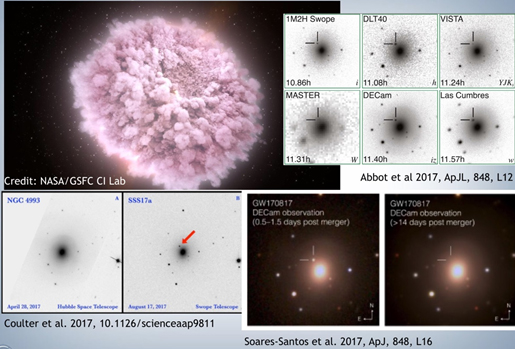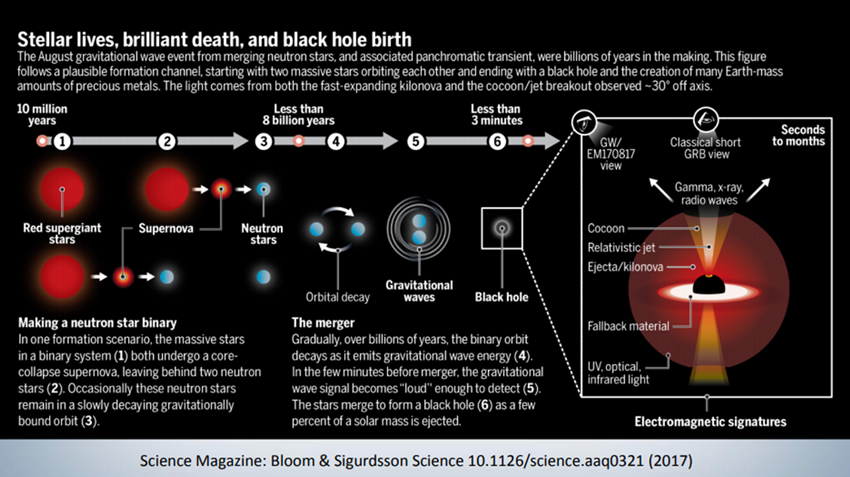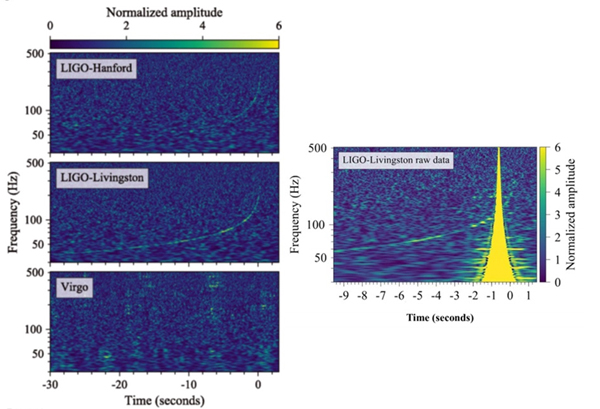The Golden Binary, continued:

In Chile ten hours after the event, the One-Meter, Two-Hemisphere (1M2H) team using the 1 meter Swope at Las Campanas Observatory made an optical observation. Within one hour, fives other teams found, observed, and confirmed it. These were: the Distance Less than 40 Mpc survey (DLT 40); VISTA in near infrared; MASTER-OAFA robotic telescope as part of the MASTER Global Robotic Net with an automated search located the optical source; optical observation by the Dark Energy Camera (DECam); and optical observation by the Las Cumbres Observatory (LCO) surveying the target area with its worldwide collection of 1 and 2 meter telescopes.
By the time that the initial research paper “Multi-messenger Observations of a Binary Neutron Star Merger” was published in The Astrophysical Journal Letters, 20 October 2017, over 3600 astronomers from more than 950 institutions made significant contributions to observations and analyses of data about this event, building upon the information and findings shared within a world-wide collaboration.
What happened? Why is it important?
 This was the first observation of the merger of two neutron stars. It was also the first time that gravitational waves have been detected from a source that was specifically located in space and observed in multiple electromagnetic wavelengths. Previous gravitational waves had been recorded from the merger of black holes that did not release electromagnetic radiation, being so dense that they immediately reabsorbed it. The observations of the merger of the golden binaries confirmed Einstein’s hypotheses that gravitational waves travel at speeds approaching the speed of light and that gravitons have negligible mass. It also confirms a current model of neutron star mergers—an accelerating and intensifying spiral as their orbits decay until they merge in a massive explosion, sending out gravitational waves, jetting gamma rays from its axes, forming a kilonova ejecting a cocoon of highly charged material emitting electromagnetic radiation and forming heavy elements that include gold, platinum, lead, mercury, uranium.
This was the first observation of the merger of two neutron stars. It was also the first time that gravitational waves have been detected from a source that was specifically located in space and observed in multiple electromagnetic wavelengths. Previous gravitational waves had been recorded from the merger of black holes that did not release electromagnetic radiation, being so dense that they immediately reabsorbed it. The observations of the merger of the golden binaries confirmed Einstein’s hypotheses that gravitational waves travel at speeds approaching the speed of light and that gravitons have negligible mass. It also confirms a current model of neutron star mergers—an accelerating and intensifying spiral as their orbits decay until they merge in a massive explosion, sending out gravitational waves, jetting gamma rays from its axes, forming a kilonova ejecting a cocoon of highly charged material emitting electromagnetic radiation and forming heavy elements that include gold, platinum, lead, mercury, uranium.
Continuing studies of radio and x-ray emissions
Chandra sensed brightening x-rays 105 days after the merger suggesting the energy in the blast wave is increasing in time possibly due to slower, higher-energy ejected materials catching up to and reenergizing the decelerating ejecta of the expanding cocoon.
What were the chances?
CalTech LIGO-affiliated astronomers calculated that the odds of observing a merger of neutron stars as 80,000 to one.
Gravitational waves are sensed by the interferometers of LIGO’s and Virgo if they are generated at an angle to Earth. They must be asymmetrical relative to Earth. Straight-on, symmetrical gravitational waves would not have been detected.
Observations were hampered by the relative position of the Sun to the merger. When optical Earth-based observatories were in daylight, they were unable to survey the target area. In space, at times the Sun also obscured the location of the merger, so continuous observations of a single type of electromagnetic radiation by the same instrument was not possible. Continuous collection of data about the merger covering the entire electromagnetic spectrum required global choreography of a collaboration of Earth- and space-based observatories.
 No similarly strong chirp was sensed by Virgo. Was this a problem with the recent upgrade or important information? Understanding that the gravitational waves were not sensed by Virgo in the same way they had been detected by LIGO and trusting that Virgo’s readings were accurate were key to determining the source of the merger. The location of the merger was somewhere in Virgo’s blind spots. Overlaying the location of Virgo’s blind spots with the data from LIGO, Fermi, and INTEGRAL made it possible to more accurately define the target region for searching for the source.
No similarly strong chirp was sensed by Virgo. Was this a problem with the recent upgrade or important information? Understanding that the gravitational waves were not sensed by Virgo in the same way they had been detected by LIGO and trusting that Virgo’s readings were accurate were key to determining the source of the merger. The location of the merger was somewhere in Virgo’s blind spots. Overlaying the location of Virgo’s blind spots with the data from LIGO, Fermi, and INTEGRAL made it possible to more accurately define the target region for searching for the source.
A glitch obscured the LIGO Livingston data. An automatic alert was not sent to astronomers. They had to scramble to remove the glitch when LIGO Hanford report its chirp.
Virgo had been shut down for an upgrade and had just started making observations 17 days before event.
One week later LIGO’s would be shut down for upgrades.
